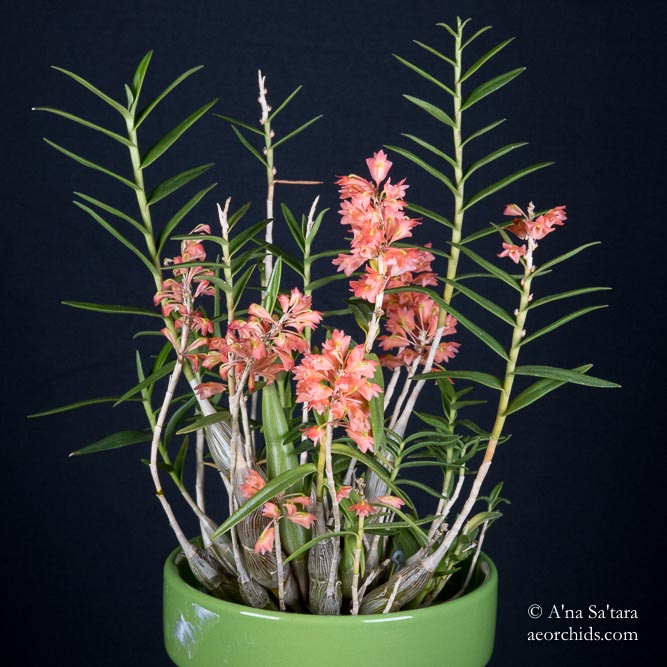Orange flares of flowers, in good timing to provide autumn pumpkin colors (at least here in central California). Dendrobium faciferum is a low elevation Indonesian species, found in the Lesser Sunda, Moluccas, and Ambon Islands below 350m (1150 feet).




The cultivar size of Dendrobium faciferum appears to vary considerably. The plant in the photos above would almost constitute a miniature, with canes 6″-9″ (15-23cm) in height, tightly filling a 4″(10cm) pot. We have a second plant with 14″ (36cm) canes, which is still quite compact. However, I have seen photos of Dendrobium faciferum grown in warmer regions of the US with canes that are over 24″ (60cm). The IOSPE describes the species as medium to large-sized, which suggests that larger plants are typical in its native habitat.
We successfully grow our Dendrobium faciferum with intermediate temperatures. I move the plants outside for the summer when nights are above 50F (10C). They tolerate bright light, growing alongside Australian Dendrobium and lower light Cymbidium, and even receive some direct low angle, late afternoon sun. By the end of the summer, the leaves tend to take on a reddish tinge, which fades when they return inside in September or October.
They are not fond of cold temperatures, as would be expected for a lower elevation tropical species, but have handled our recent summer heatwaves (100F/39C and higher) quite well. Given that they have narrow, succulent leaves and large basally rounded pseudobulbs, I would expect that Dendrobium faciferum experience high light and dry conditions in their native habitat.
Our Dendrobium faciferum spend the winter in a southeastern window and are kept quite dry for a few months (watering lightly every 3-4 weeks at most). Summers bring heavier watering, generally 2-3 times per week, depending upon the temperatures.
We generally observe one significant bloom in late summer or early autumn, as the nights begin to cool down. Often there is a second, smaller bloom cycle in late spring.
Interested in more unique and beautiful orchid images?
My vision to create orchid portraits emerged from my appreciation for the “whole orchid.” So many photographs of orchids focus only on the flower. But orchids are not flowers: they are entire plants and living beings. Connect more deeply with the many dimensions of orchids …









